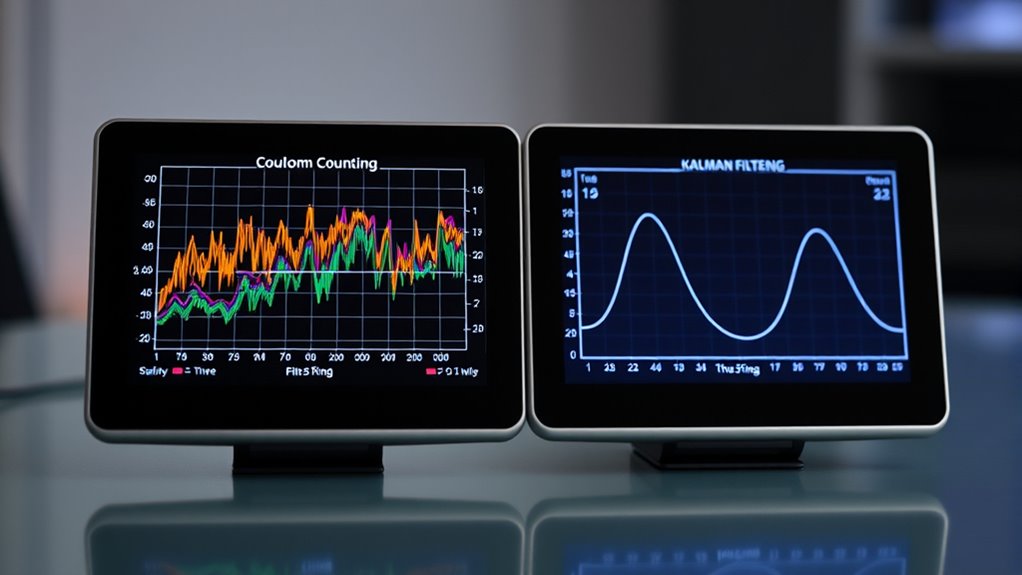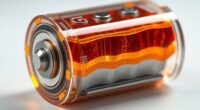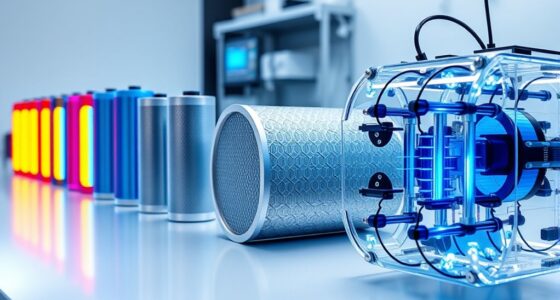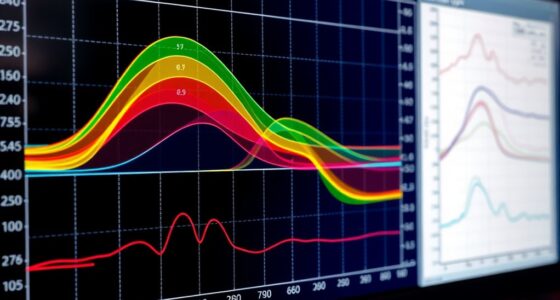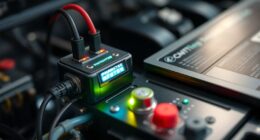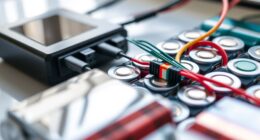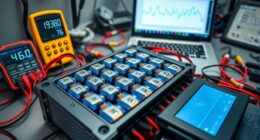Choosing between Coulomb counting and Kalman filtering depends on your system’s needs. If you prioritize simplicity and quick implementation, Coulomb counting is your best bet, but watch out for drift over time. If you want higher accuracy and robustness against noise, Kalman filtering excels, though it’s more complex. To optimize your SoC estimates effectively, understanding both methods and their trade-offs can make a big difference—keep exploring to find out more.
Key Takeaways
- Coulomb counting is simple and fast but prone to drift, making it less reliable for long-term accuracy.
- Kalman filtering offers superior precision and noise compensation but demands more computational resources.
- A hybrid approach leverages Coulomb counting for quick estimates and Kalman filtering for refinement.
- Coulomb counting suits low-resource systems needing immediate responses, while Kalman filtering excels in long-term, accurate monitoring.
- Accurate battery modeling enhances Kalman filter performance, reducing errors and improving SoC estimation overall.
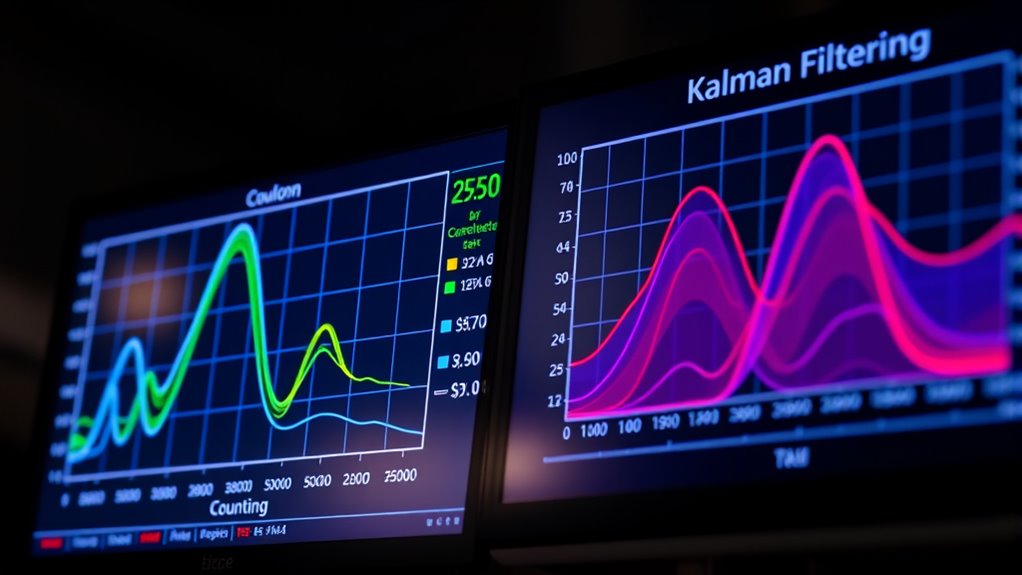
When it comes to estimating battery state of charge, two common methods—Coulomb counting and Kalman filtering—offer different advantages and challenges. If you’re looking to improve your battery management system, understanding these approaches helps you choose the right one. Coulomb counting is straightforward: it tracks the amount of charge entering and leaving the battery, providing a direct measurement of the state of charge (SoC). Its simplicity often means faster implementation and lower computational demands. However, its battery accuracy can suffer over time because small measurement errors accumulate, leading to drift. This drift requires periodic recalibration, which can be inconvenient or impractical in some applications. Additionally, Coulomb counting struggles with sensor inaccuracies or interruptions, making it less reliable in dynamic or noisy environments.
Kalman filtering, on the other hand, employs a more sophisticated algorithm to estimate the SoC. It combines multiple sensor inputs and models of battery behavior to produce a more consistent and accurate reading. This approach typically results in superior battery accuracy over long periods, as it actively compensates for measurement errors and noise. But this improved accuracy comes at a cost: the algorithm complexity increases considerably. Implementing a Kalman filter demands a good understanding of the underlying mathematical principles and more processing power, which might not be feasible for all devices or systems with limited resources. As a result, integrating Kalman filtering requires careful design and tuning to ensure it performs at its best without overburdening your hardware.
Furthermore, understanding the role of accurate modeling of battery dynamics can significantly enhance the effectiveness of Kalman filtering, especially in complex systems. If you’re balancing these factors, consider your application’s needs. For instance, if you prioritize real-time response and have limited computational capacity, Coulomb counting might be the better choice despite its drift issues. Conversely, if long-term accuracy and robustness against noise are critical, investing in a Kalman filter can pay off, provided your system can handle the algorithm’s complexity. Some advanced systems even combine both methods, using Coulomb counting for quick initial estimates and Kalman filtering for refinement.
Ultimately, your choice hinges on the trade-offs between battery accuracy and algorithm complexity. Coulomb counting favors simplicity but faces challenges with drift and sensor errors, while Kalman filtering offers precision at the expense of increased computational demands. Recognizing these differences helps you optimize your battery management strategy, ensuring reliable and efficient operation tailored to your specific needs.
Frequently Asked Questions
How Do Environmental Factors Affect Coulomb Counting Accuracy?
Environmental factors like temperature drift and sensor aging can substantially impact Coulomb counting accuracy. When temperatures fluctuate, battery chemistry changes, causing measurements to become less precise. Sensor aging reduces reliability over time, leading to errors in current readings. You need to regularly calibrate sensors and account for temperature variations to maintain accurate State of Charge estimates, ensuring your battery management system remains reliable despite these environmental influences.
Can Kalman Filtering Adapt to Rapidly Changing Battery Conditions?
You might think Kalman filtering can’t keep up with rapid battery changes, but its adaptive algorithms excel at this. By intelligently fusing data from multiple sources, it adjusts in real-time to shifting conditions. This flexibility makes Kalman filtering far more responsive than simple Coulomb counting, especially during sudden load changes or environmental shifts. So, yes, it effectively adapts to rapidly changing battery conditions, ensuring more accurate state-of-charge estimations.
What Are the Computational Requirements for Each Method?
You’ll find that Coulomb Counting has lower computational complexity and minimal hardware requirements, making it simple and cost-effective to implement. In contrast, Kalman Filtering demands more processing power and sophisticated hardware, due to its advanced algorithms and real-time data processing. If you need a lightweight, easy-to-deploy solution, Coulomb Counting suits you. But for higher accuracy in complex conditions, Kalman Filtering’s hardware requirements are justified.
How Do Calibration Needs Differ Between Coulomb Counting and Kalman Filtering?
You’ll find that calibration needs differ considerably between Coulomb Counting and Kalman Filtering. Coulomb Counting has higher calibration complexity because it depends heavily on precise initial capacity and current sensors, which require frequent calibration. In contrast, Kalman Filtering adapts to sensor drift over time, making it less sensor-dependent and reducing calibration efforts. This means you’ll spend more time calibrating Coulomb Counting systems, while Kalman Filtering offers easier ongoing calibration.
Are There Hybrid Approaches Combining Both Methods for Better Accuracy?
You can improve accuracy by using hybrid integration, which combines techniques like Coulomb counting and Kalman filtering. This approach leverages Coulomb counting’s direct current measurement and Kalman filtering’s predictive modeling, reducing calibration needs and compensating for drift. By combining methods, you get more reliable state-of-charge estimates, especially under variable conditions. Implementing such combined techniques offers a balanced, robust solution tailored for better overall SoC accuracy.
Conclusion
Ultimately, choosing between Coulomb counting and Kalman filtering depends on your needs. Coulomb counting is simple but can drift over time, while Kalman filtering offers more accuracy by fusing data intelligently. Remember, “A chain is only as strong as its weakest link”—so pick the method that best complements your system’s strengths and weaknesses. Whichever you choose, understanding their limitations will keep your SOC estimates reliable and your device running smoothly.

